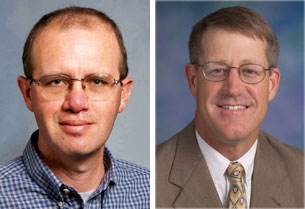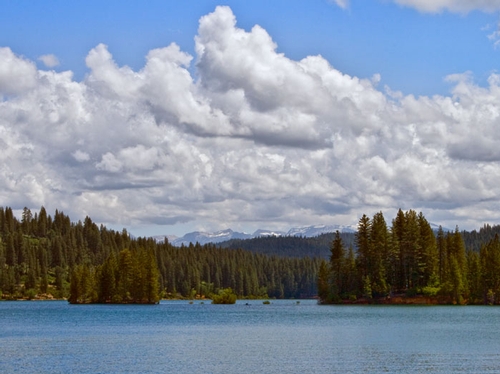Posts Tagged: grazing
Scientists to minimize impact of High Sierra grazing
University of California, U.S. Forest Service and other agencies will work together to understand the impact of cattle grazing in the High Sierra and look for solutions to water quality problems, according to an article in the Sonora Union Democrat.UC Davis Cooperative Extension watershed specialist Ken Tate and interim director of the Western Institute for Food Safety and Security at UC Davis Rob Atwill will design and conduct the study. The first samples have already been collected.
In the story, writer Ashley Archibald reported that the scientists are seeking to fix problems, not just document them.
“It’s good to focus on what are the practices that can move us forward so everyone can enjoy the national forest since it has a multiple use mandate and is a resource for the public, and the public is pretty diverse," Atwill was quoted.
Scott Oneto, the director and farm advisor for the UC Cooperative Extension in Calaveras and Tuolumne counties, said the scientists are still looking for input on how to build a comprehensive study.
The California Farm Bureau Federation's weekly publication AgAlert
also weighed in on the new study. The paper said the scientists held a briefing for ranchers in Sonora where they explained their desire to acquire data to demonstrate the relationship between grazing on public lands and water quality requirements.
The article - written by AgAlert editor Kate Campbell - noted that the scientists will take multiple water samples from 48 different sites in the High Sierra over the next several months, with preliminary results available by the end of this year. Sites will include areas used for grazing and recreation.
Cattle ranching offers notable public benefits
The Sierra Nevada and Coastal Range foothills are replete with wide open spaces - a home for birds and other wildlife, majestic oaks and grazing cattle. The bucolic countryside vistas that come courtesy of California’s ranchers are among the many public benefits of rangeland grazing.
“The public doesn’t always realize what ranchers are doing and how that benefits everyone,” said Bill Tietje, UC Cooperative Extension natural resources specialist based in San Luis Obispo County. “No one really thinks about it, until it’s gone.”
Many rangeland benefits can be grouped as “ecosystem services.” According to scientists:
- Rangeland plays a role in the state’s water cycling. Eighty percent of California water flows through rangeland.
- The diversity of plants and animals is greater on grazed, managed grassland than on unmanaged grassland.
- Wild raptors overwinter on grasslands managed for beef cattle.
- Half the habitat for the tiger salamander is grazed stockponds, created by ranchers to provide water for their cattle. The stockpond’s edge of clipped grass and the absence of crowding shrubbery mimic the rare species’ natural habitat – vernal pools.
- Rangeland provides habitat for insects that are valuable for pollination.
- Cattle reduce the dry grass that could fuel wildfire.
- Grazing improves the habitat for the Bay checkerspot butterfly, a threatened California insect.
- Rangeland sequesters carbon in the soil.
There are threats to the long term viability of cattle ranches in California that put all these benefits at risk:
The sale of the ranch for development is very attractive for a rancher who isn’t making a sufficient profit on the land. Also, the division of a ranch for inheritance purposes can make it difficult to keep a ranch intact and in the business of raising cattle.
UC Berkeley professor of rangeland management and ecology Lynn Huntsinger said public misunderstanding of and a lack of appreciation for ranching is another way the system is threatened.
“Imposing regulations that aren’t needed and not valuing ranchers as stewards can have a demoralizing effect,” Huntsinger said.
Much of the land grazed by ranchers is public and grazing is supported by public and environmental agencies - the U.S. Forest Service, Bureau of Land Management, parks and preserves - because of the many benefits it provides.
Public Benefits of Grazing
Researchers respond to Sac Bee Sierra grazing story
UC Davis Cooperative Extension researchers Ken Tate and Rob Atwill responded to a story about High Sierra grazing published last month in the Sacramento Bee in the California Farm Bureau Federation's newspaper AgAlert.
The Sacramento Bee story suggested that cattle grazing in high-elevation areas of the Sierra Nevada causes water contamination. Following is an opening excerpt of Atwill and Tate's commentary. See the AgAlert link for the complete 600-word response:
"Our shared challenge is to continue to identify and enact grazing practices which reduce pollution risks, enhance watershed health and sustain agricultural enterprises.
"All of our local communities are reeling from budget blows and decreasing revenues. Our local rural communities depend on livestock grazing and associated businesses for a stable economy.
"Sustainable food production and natural resources are crucial to our state, country and world. We all depend upon healthy watersheds."

Ken Tate, left, and Rob Atwill.
Forest Service works with UC to ensure water quality
U.S. Forest Service regional forester Randy Moore said the agency and its collaborators take the quality of high Sierra water seriously, according to an op-ed article that ran in the Sacramento Bee over the weekend.
The op-ed came after a May 1 Sac Bee editorial encouraging the Forest Service to limit grazing to lower elevations.
Moore wrote that the Forest Service is working with the State Water Resources Control Board to develop a water quality management plan for California national forests. The plan will establish best-management practices for controlling non-point source pollution like that produced by grazing cattle.To develop the practices, Moore said the agencies are looking at a large body of peer-reviewed literature examining the relationship between livestock and water quality. The studies were conducted by respected environmental researchers, he wrote, specifically naming UC Davis Cooperative Extension specialists Ken Tate and Rob Atwill.
UC Davis researchers have offered to work with the Forest Service to design monitoring and research that is scientifically credible and provides information that will ensure the safety and quality of watersheds, the op-ed says.

A lake in the high Sierra. (Photo: Mike Poe.)
UCCE farm advisor explains rangeland irony
Forage monitoring at the UC Sierra Research and Extension Center in Browns Valley shows the land produced, on average, 2,984 pounds of vegetation per acre, 93.4 percent of normal, according to an article published today in Capital Press. That may sound fantastic - 93.4 percent looks like an A to me. But UCCE farm advisor Larry Forero said that the growth came too late for most ranchers.
In fact, in nearby Tehama County, officials are seeking a federal disaster declaration because of drought damage to its rangelands. Reporter Tim Hearden wrote that neighboring counties may follow suit.
The problem may not be too little rain, but the timing of the rain. Much of the vegetation grew after April and May storms, Forero said. By that time, some ranchers - concerned about the lack of forage on the foothill land - had already moved their cattle to higher-elevation summer pastures or to irrigated pastures.
The fact that vegetation was left behind may prove helpful in the fall when cattle return to the range. But Northern California ranchers took another blow when it rained in early June.
This late rain can sometimes do more harm than good, Forero told the reporter. When the grass is dry, rain can leach it and reduce its nutritional value.
"This is an incredibly complicated business," Forero told me when we spoke this morning.

Forage was below average each month of '09 season.



